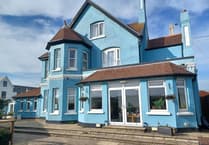PA23/07613: PLANS for the conversion of a popular hotel and resort into over 100 ‘apart-hotels’ have been refused by Cornwall Council.
Osbourne31 Ltd applied to the local authority for permission for the change of use at Hustyns, Burlawn, Wadebridge.
They sought permission from Cornwall Council for a certificate of lawfulness for the proposed use for internal alterations and a change of use from hotel premises (class C1) to holiday let apartments.
The plans would see the hotel accommodation changed to become 116 serviced holiday apartments.
It would become the latest in a number of acquisitions by the applicant, which presently runs four ‘apart-hotels’ similar to the plans at Hustyns, comprising of one in Ilfracombe, two in Eastbourne and one in London.
In the application, the applicants told Cornwall Council: “This site lies well outside the settlement boundaries of Burlawn village and comprises a purpose-built three-storey hotel with various projecting bays and rooflines along its length.
“There is a central semi-octagonal block accommodating a two-storey function room together with conservatory.
The main structures are of modern shallow pitched roof design with dormers and are set into the contours of the land.
“In essence, the application relates to the proposed works being lawful in scope and use class by virtue of continuing the hotel use within which the complex has operated since being built. The difference would be that each room would be given kitchenette facilities in order to allow guests the ability to cater for themselves in the style of an apartment.
“In terms of daily upkeep of both communal areas and individual rooms, cleaning staff are employed. Furthermore, reception staff would be stationed at a foyer desk in the style of a hotel and private cooking and sitting areas would be available in each room. Such a concept is known as an ‘Apartment-Hotel’ or ‘Apart-Hotel’ and has been established elsewhere in the country as demonstrated by the precedents noted above
“The recognised use class for such facilities is C1. This means that the Hustyns Resort Hotel complex being already in C1 use as a hotel would remain in the same use class. As may be seen, the predominant hotel character would be retained if the proposal were permitted. Therefore, the plans show that the criteria for lawful development would be met.
“It is therefore requested that the local planning authority consider the following in granting a Certificate of Lawfulness of Proposed Use or Development for the works in line with the legal framework.
“The application site, Hustyns Resort Hotel, would be converted together with the ancillary staff accommodation to the Apart-hotel use as demonstrated in the plans accompanying this application. It is proposed to work within the confines of the existing structure with the change of use involving no changes to the building’s exterior.
“Currently, there are around 37 rooms in the hotel use with the lower ground/ground floor of the Hustyns Hotel consisting of formal restaurant, bar and lounge seating areas with leisure spaces including swimming pool, spa/sauna, children’s play as well as kitchen/storage facilities. The proposal would involve most of these areas being subdivided into individual room accommodation with kitchenette facilities.
“The rest of the floor and levels above would also be changed from hotel rooms to serviced apartment rooms. Minimal changes involving installation of windows where there are already openings would not materially affect the exterior.
“Where there are currently kitchen/dining/lounge facilities on the ground floor. Also there are further bedrooms proposed in the further wing extensions either side of the main block with further staff rooms as follows: Lower ground floor – 63 rooms, ground floor – 37 rooms, first floor – 16 rooms.
“It is emphasised that the application forms part of a coherent whole which contributes to the continued use of the facility for employment purposes, serving a valuable local tourism market. All the works are compliant with the above criteria for the Certificate of Lawfulness of Proposed Use/Development.
“It is considered that the proposal would provide high-quality ‘Apartment Hotel’ accommodation at the Hustyns Resort Hotel within the same use class (C1) and would not have a negative impact on either the appearance of the area or the amenities of adjoining occupiers.
“The proposal is consistent with the legislative framework in terms of the internal nature of the works with no material effect on the external appearance and character of the building. Consequently, it is considered that the works would contribute to a beneficial reuse of these buildings, maintaining the local visual environment and respecting the character of the surrounding Area of Great Landscape Value.
“The proposal complies with all legislative provisions for lawful development, integrating with the surrounding countryside and local tourism-related uses.
“The Council are respectfully requested to grant a Certificate of Lawfulness of Proposed Use or Development (CLOPUD) for the works.
The current swimming pool and spa facilities at the hotel would also be converted into holiday apartments.
However, the application for the change of use was refused by Cornwall Council, who said that full planning permission would be required for the development proposed.
They said that due to the scale of the alterations required, in addition to the building having a different use to how it was built, it would require full planning permission.
An accompanying planning officers report concluded: “Based on the submitted evidence and the description of the LDC application, the proposed change of use of the hotel building is not considered to comply with section 55(2)(a) of the Act as the proposed change of use would involve development which would not affect only the interior of the building.
“Additionally, it would not accord with section 55(2)(f) as the conversion of the hotel premises to holiday let apartments would constitute a material change of use by reason of the different character and impact on the site, and off-site, in terms of the social and environmental conditions it would result in. Planning permission is therefore required for the proposed change of use of the hotel premises to holiday let apartments.”
λ Continued from page 35
Refusing the permission, Cornwall Council told the applicant: “On the basis of the documentation provided, the Local Planning Authority considers that the proposed use for internal alterations relating to the change of use of hotel premises to holiday let apartments, at Hustyns Resort Hotel Burlawn Wadebridge Cornwall PL27 7LG, would require planning permission as the proposed use is considered to constitute development in accordance with section 55(1) of the Town and Country Planning Act 1990 (as amended).
“This is because the proposal would require carrying out alterations in order to enable the proposed change of use of the building, and it would amount to a material change in the use of the hotel premises.”
PA23/05552: The proposed erection of a new agricultural building for the storage of machinery and fodder as well as associated landscaping to achieve hardstanding at a farm in Pensilva has been refused by Cornwall Council.
Gwen Renfree applied to the local authority for permission to undertake the work at land at Highdown Farm, Charaton Road, Pensilva.
The applicant told Cornwall Council the proposed building was essential to improve the economic viability of the 125-acre farm, improve security and extend the serviceable life of farm equipment.
They further argued that not doing so and leaving equipment to the elements would reduce its service life and increase maintenance costs.
There were no objections to the planning application from members of the public, while St Ive and Pensilva Parish Council said that they supported the application.
However, it was refused by Cornwall Council, who said that it was unsympathetic and non-contributory to the local landscape setting, and thus would be a ‘large and overbearing’ physical structure, which in its view was not designed or sited to be integrated in the existing built form of the farming unit and would not limit its visual impact.
An accompanying officers report detailed the reasons given by the applicant for the location of the proposed building and Cornwall Council’s concerns about that location, saying: “The applicant has advised that the location of the building is due to concerns over security (owing to the access to the wind turbine running through the site), however, officers argue that the most logical place to site the new building would be amongst the existing cluster alongside the farm managers dwelling where a higher level of surveillance would be possible.
“Very little additional information has been provided in terms of design; however, it is anticipated that there would be a need for lighting to the area which has the potential to result in light pollution in this otherwise undeveloped rural area.
“Taking these factors into account, on balance it is not considered that the proposed development is acceptable by means of its siting and design which would result in harm to the character and landscape qualities of the AGLV.
“All other matters raised have been taken into account, and in the absence of any significant benefits which would outweigh the harm identified, the application is recommended for refusal.”
In refusing the application, Cornwall Council told the applicant: “By means of the siting and design of the proposed agricultural building which would require extensive earthworks, the proposed development would result in a significant change to the topography of the landscape creating an unnatural platform with a jarring appearance within the wider setting.
“In addition, the introduction of a large and overbearing physical structure which has not been designed or sited to be integrated within the existing built form of the farming unit nor limit its visual impacts.
“The development would not be sympathetic nor contribute to the local landscape setting and would materially harm the character and distinctive landscape qualities of the Area of Great Landscape Value contrary to Policies 1, 2, 12 and 23 of the Cornwall Local Plan Strategic Policies 2010 - 2030 (adopted November 2016), Saved Policy CL9 of the Caradon Local plan and Paragraphs 88, 135 and 180 of the National Planning Policy Framework 2023.”

.jpeg?width=209&height=140&crop=209:145,smart&quality=75)



Comments
This article has no comments yet. Be the first to leave a comment.